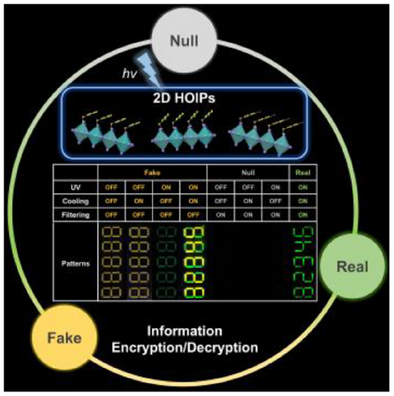High-Security and High-Efficiency Information Encryption/Decryption Based on 2D Hybrid Organic–Inorganic Perovskites via Delicate Organic-Cation Engineering
Graphical Abstract
We develop a unique strategy of information encryption/decryption based on stimuli-responsive luminescence of 2D hybrid organic–inorganic perovskites via delicate organic-cation engineering. The facile triple-key implementation working in multiple switching modes (featuring high contrast and quick response) allows us to achieve high security and readout efficiency, opening a new door to information security based on optical encryption.
Abstract
Optical encryption based on stimuli-responsive luminescence (SRL) materials has received enormous interest in the field of information security. Metal–halide perovskites, as a newly emerging SRL material, have shown great potential for confidential information encryption/decryption (InfoED) applications. However, it is rather challenging to ensure high security and achieve high readout efficiency in perovskite SRL-based InfoED. Herein, we present a unique InfoED strategy using 2D hybrid organic–inorganic perovskites via delicate organic-cation engineering, benefiting from the high contrast and quick response of their photoluminescence behaviors. Indistinguishably encrypted information can be efficiently decrypted through triple-key implementation (i.e., ultraviolet-light irradiation, temperature control, and narrow-bandpass filtering) that operates in multiple switching modes, enabling us to demonstrate extremely high security by adopting dot-matrix patterning scenarios that are virtually uncrackable. As a proof of principle, a simple 2 × 2 patterning can yield a code dictionary with random variants as high as ∼1047, which will take as long as ∼1022 years to crack using the hitherto fastest supercomputer, El Capitan. Our perovskite SRL-based InfoED strategy provides a promising solution for information security based on optical encryption.
Conflict of Interests
The authors declare no conflict of interest.
Open Research
Data Availability Statement
The data that support the findings of this study are available in the Supporting Information of this article.





